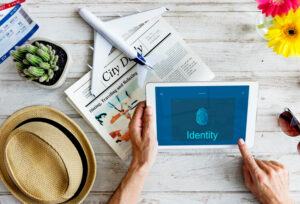The Fintech sector combines technology and finances in order to create technical solutions in the financial field. It revolutionized the way we manage finances and make transactions and allowed us to move from the constant use of cash, which can be not secure and inconvenient, to monitoring all our finances using just a smartphone.
Fintech applications allow us to instantly pay for products and services, receive and send money, invest, exchange, and make other financial transactions in a matter of seconds. Such applications are mostly divided into:
- Digital Banking
- E-wallets
- Finance Management
Each type has its own approach to application design and architecture. In this article, we talk more about them, their features and differences.

- Digital Banking
Fintech has had a significant impact on traditional banking, fostering the appearance of digital services in the finance industry. Digital banking has allowed financial institutions to cut operational expenses, allowing them to concentrate on the users’ needs and provide a smooth and seamless experience. Neobanks (digital banks) have recently emerged, and they often partner with traditional banks to secure their financial operations. Since neobanks don’t have offices, they can provide all the services remotely. And this is beneficial both for them and the users.
The key features of digital banking are:
- The mobile-first approach allows users to manage their financial and banking operations on the go from wherever they are using their smartphones.
- No physical branches or, at least, no need to use them for most banking operations – opening an account, closing the card, etc.
- Innovative services like expense categorization, budgeting tools, financial insights, etc.
Digital Banking App Features
The mobile-first approach led to the emergence of banking apps and systems. Revolut, PayPal, and Chime — are all examples of such services. They are packed with useful features that allow users to take the most out of their experience with the app while managing their budgets and expenses.
The most important digital bank features include:
- Easy registration process — registration and opening an account/issuing the card only take a few minutes and clicks.
- Real-time notifications allow tracking of all payments and transfers.
- Management tools like showing the budget summaries and spending patterns in a clear way using charts and dashboards.
- Integration with third-party services — these include partnerships with various companies so that users can use their products right from the online banking app (insurance, digital wallets, etc).
- Apps for E-wallets
Electronic or digital wallets allow users to actually use the money they have in online banking to pay for things. They work through an online platform and are linked to the bank cards or accounts the user has. Some of them allow for storing ID cards, tickets, driver’s licenses, etc. Overall, it’s a safe way to store and manage payment methods.
E-wallets can be differentiated by access to them:
- Open wallets can be used only for transactions between the issuing bank and another major bank.
- Semi-closed wallets only allow for making transactions at certain merchants or locations.
- Closed wallets can only be used by certain people, for example, a company’s customer (like Amazon Pay).
Most e-wallets work using NFC technology (Near Field Communication) — like Apple Pay and Google Pay. Some use Quick Response Codes or Magnetic Secure Transmission. The rules for using e-wallets may vary from country to country and they may be limited or prohibited in some states.
E-wallet App Features
E-wallets provide a fast and secure way to manage payment tools. Since you often need the money on the go, these apps have additional convenient features to streamline financial operations:
- Quick user registration basically only means indicating your ID and adding the Face ID.
- Card authorization to connect a debit or a credit card to the wallet.
- History of transactions, allowing you to keep track of the conducted financial operations.
- Bill payments for automated payment for utilities and subscriptions.
- Account balance management that includes adding funds and checking their amount.
- Push notifications to keep the user informed about all recent activities.
- Loyalty reward offers like cashback or discounts to loyal users of the wallet.

- Personal Finance Management App
Finance management apps are another popular implementation of fintech solutions. In 2018, around 63% of smartphone users had at least one financial app. In recent years, however, this number has increased to over 70% of users. This shows us that the trend for managing finances is only rising.
One of the biggest advantages of Fintech solutions is providing users with the possibility to manage their finances without involving the banks in the process. Personal finance management apps are usually connected with digital banking, so people can track expenses and earnings, view statistics, and plan budget spending. Funds management applications can help users set long-term financial goals and achieve them by using automated features like spending limits and auto-saving features.
Personal Finance App Features
Finance management apps allow users to gain control over their budgets and manage finances effectively. Their most useful features include:
- Transaction management allows to monitor all operations for all accounts and categorize them.
- Tracking expenses and earnings to see the ratio of money spent to the money earned.
- Achieving financial goals that can be saving for a large payment, paying off debt, investment, etc.
- Saving feature that can be automated to set aside some percent out of earnings in a given time period.
- Adjusting financial behavior by identifying the areas where you spend the most or the least and correcting them.
4 Fintech Design Challenges
Designing a fintech app is quite a challenge since personal finances are a delicate matter. That’s why it should be convenient and user-friendly, work smoothly, manage complex workflows, and be super-secure. The main formidable challenges are discussed below.
- Maintaining Simplicity/Compliance Balance
A finance app should be simple enough for users to navigate through their routine financial tasks. Yet, it has to comply with all the regulatory and legal requirements that can complicate the design. For example, it would be very easy to create autofill login data or account details on the smartphone without having to fill it out every time. But according to some personal data requirements, websites or apps can’t store such data and auto-fill it.
However, there are some methods to navigate through user-friendliness and compliance.
- Ensure transparent communication. Make sure to clearly explain why you need some information, how, where, and for how long it will be kept. Let the user know that some features are not just the developers’/designers’ whim but a necessity to meet legal standards.
- Collaborate with legal and compliance experts. The legal world has so many nuances that it’s easy to forget or omit them. Although omitting some of them might make the customer journey easier, it may lead to compliance issues jeopardizing the whole app — and the users’ money.
- Test and gather feedback. The user is the main person that can help you hone the app. Thanks to their feedback, developers will know which features they can sacrifice to make the app simpler and get valuable insights to make informed design solutions.
Overall, since there is money at stake in financial apps, users will likely be more willing to let go of the maximum simplicity to ensure the safety of their funds.
- Managing Complex Financial Workflows
Fintech applications have peculiar workflows — the sets of features for achieving some goal. They often involve intricate processes such as account setup, transaction management, or investment tracking. Such flows should be presented to users clearly, which is not always the case.
There are some approaches to managing such complex tasks:
- Use information hierarchy. Utilize all the markup tools at your disposal – headings, subheadings, labels, lists, etc. This will allow the user to understand more clearly the action they need to take.
- Visualize data. It’s already been proven that some complicated things can be better explained and memorized using visualization instead of textual description. Plus — it will save a lot of space in the app and make it easier for users to focus on.
- Provide the necessary guidelines and support. Add instructions or guides to explain the intricate processes. Ensure you have a skilled support team to answer the questions and address the issues the user might experience.
- Get users’ feedback by testing the flows. Ideally, it’s best to conduct user testing and interviews at every stage of design. This will not only allow them to meet their needs but will help to identify their pain points and areas of confusion.
- Ensuring Cybersecurity
One of the most challenging aspects for an app in general, and a financial app in particular, is ensuring the highest levels of cybersecurity. Developers must follow the best coding practices to implement the latest security measures, including input validation and API integration.
We all know that the password problem is a number one headache for both developers and users. That’s why there must be strong authentication mechanisms in place: MFA, 2FA, hashing, and so on. Users must be aware of the fact that using one password for all apps is dangerous — implementing pop-up messages with password requirements is a great idea.
The work of fintech apps entails constant communication between the app and the server. This also requires powerful security mechanisms so as not to compromise sensitive financial data. Various encryption protocols are meant to encrypt this app-server interaction and turn malicious people away.
- Keeping up with Technological Advances
In order to quickly adapt, you have to think about scaling in advance and choose the technology that is flexible and allows for future development. You can build a foundation and then use modular design — to change and adjust its parts when new solutions appear. This will ensure the continuous development and improvement of the app without having to build it again from scratch.
Another way to go might be embracing some Agile methodologies. Things like iterative design and development cycles will allow the team to make iterations quickly and smoothly. They will also help with the integration of the new features and updates.
How RoveTek Can Help You to Design a FinTech App?
Building and maintaining a fintech app may be a difficult task. It’s not easy to navigate between simplicity, efficiency, and user satisfaction. That’s why you need a dedicated team of professionals well aware of current technology trends and skilled in design solutions for the finance sector.
At RoveTek, we specialize in fintech and have deep expertise in designing applications tailored for the finance sector. Our experienced team of developers consists of back-end and front-end specialists ready to implement your vision. We will also ensure the security, stability, and compliance of the app with the regulations at each point of the design process.














